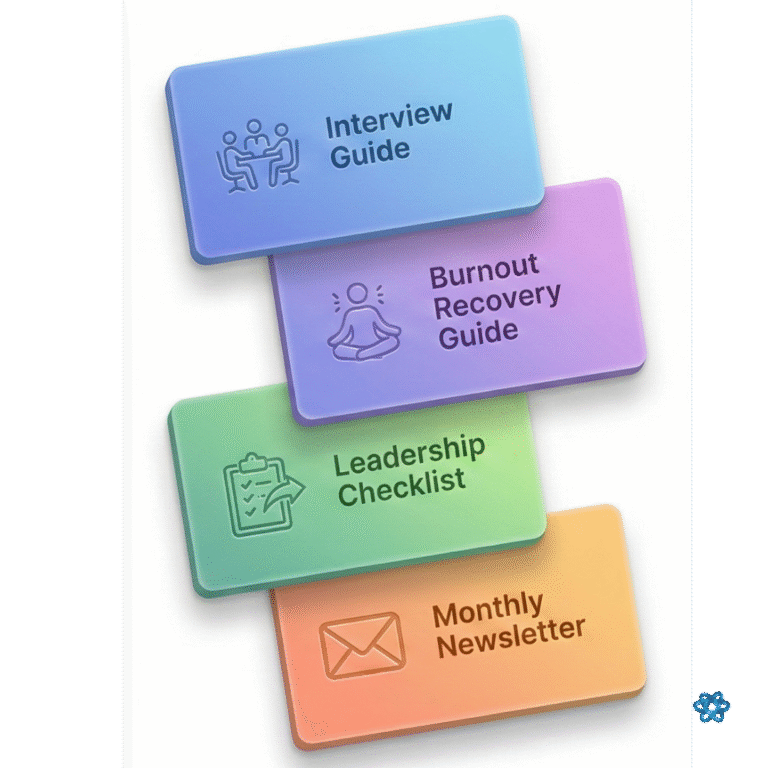
We’ve all been there. The Sunday Scaries hit hard, the morning alarm feels like a ten-ton weight, and you’re just… going through the motions at work.
You’re getting things done, meeting your deadlines, and cashing the paychecks, but that spark? The real, honest-to-goodness excitement for what you do? It feels miles away.
Here’s the thing: you’re not lazy! You’re likely just running on the wrong kind of fuel, and hopefully not working in a toxic workplace (LINK).
Most of us know extrinsic motivation like the back of our hand. It’s the drive to do stuff for external rewards—like money, a promotion, or a pat on the back. It’s the classic carrot-and-stick, and it works!
But it eventually runs out. Real, long-lasting success and that feeling of loving your job come from its way more powerful sibling: intrinsic motivation.
Intrinsic motivation is the juice that comes from within. It’s that buzz you get from cracking a tough problem, the fun of learning something new, or the feeling of purpose when you know your work matters. It’s when your job just clicks with who you are. People who are intrinsically motivated are happier, more creative, and just plain better at their jobs (Gagné & Deci, 2005).
The best part? This isn’t some magical trait you’re born with. It’s a skill you can build. If you’re ready to stop just “doing the work” and start actually loving it, here are seven simple things you can do to fire up your intrinsic motivation, starting now!
Click here to learn more about motivation (LINK).
Figure out your why (Finding your purpose)
Simon Sinek is created with “Start with Why”?
Why is that important? It’s because when we know our purpose, it’s like our internal compass, GPS, that tells us if we’re going the right direction or if we’ve veered away from our purpose. These is a motivation draining indicator and can cost us a lot of time and energy to recover or justify our new patch.
Seriously, the biggest driver of motivation is knowing your purpose. When you get why your work matters—beyond the boring tasks and your official title—it changes the whole game.
This doesn’t have to be some huge, “change the world” mission (but it can be!). It’s just about connecting what you do every day to something bigger: helping your team succeed, making a client’s day, or even just becoming a better version of yourself.
Without a clear “why,” even the coolest job can feel like a random list of chores. I’ve been searching for my purpose for decades, why am I here? What am I doing with my life? What is my ikigai?
Once I took a reflection moment, I recognized it didn’t matter what type of work I was doing. As long as I was in a space to help at least one person grow, I was connecting with my why. I was living my purpose. While coaching over 3,000 individuals, I’ve gotten to help several people grow and develop into unstoppable force for their vision and nothing gives me more joy.
So, let’s focus on you. Take 30 minutes, and actually take the time, and work on this purpose map by reflecting on these questions:
-
Who actually benefits from my work? (Think: clients, your team, the company, your family).
-
What part of my job makes me feel the most proud?
-
If I had to tell a friend what my impact at work is, what story would I tell?
Use your answers to write a one-sentence “Purpose Statement.” Stick it on a Post-it where you can see it!
Let me know how you feel after that one week. My guess, you’ll make some changes in your outlook and might even find the motivation to start reconnecting with your work.

Find your autonomy (take the driver's seat)
Micromanagement is a motivation killer.
Micromanagement is a motivation killer.
No micromanager ever accomplished incredible work, they managed people and made like harder on everyone. This is why it’s a trait of a toxic leader (LINK). There’s this great idea in psychology called Self-Determination Theory (SDT), which basically says we all have a deep need to feel in control of our own lives (Deci & Ryan, 2000). When we get to make choices about how, when, or where we work, our sense of ownership goes through the roof.
Unfortunately, you probably can’t control everything, but you can always find a way to take some control. For example, speaking with your manager and team and allow you to negotiate how to take back some control while delivering exceptional work. There’s almost always a small way to take the wheel. Proactively looking for these chances tells your brain that you’re the one driving your career, not just a passenger along for the ride.
Again, take another 30 minutes to complete this activity, these strategies help you boost your intrinsic motivation and helps to regain control of what drives you. Find one small thing you can take charge of this week:
-
Could you suggest a better way to organize that weekly report?
-
Could you volunteer to set the agenda for the next team meeting?
-
Could you block off “focus time” on your own calendar?
Start small, show you’ve got it handled, and watch your motivation grow! Every step towards building your autonomy is a win.
Chase progress and not perfection (build competency)
Imposter Syndrome (LINK) lives in our need for perfection, it can have a severe impact on our motivation to continue our progress, we get discouraged and stop pursuing what aligns with our why. The second big need from Self-Determination theory is competence: that awesome feeling of being good at what you do.
Sure, hitting a sales target feels great, but the real, lasting satisfaction comes from knowing you became a better negotiator or a sharper presenter to get there. Stop obsessing over the results and focus on your effort. When you shift your goal from just “hitting the numbers” to “improving my skills,” progress itself becomes the reward.
Challenges stop being scary and start becoming chances to level up. Why not take another 30 minutes on these activities to level up:
Pick one skill that’s important for you and try to get just 1% better this month.
-
Read one article or watch one video on a specific skill.
-
Practice a new keyboard shortcut for 15 minutes.
-
Ask a coworker you trust for one piece of feedback.

Make friends (connect with others)
My mom was right all along, having friends make things easier and better.
The last piece of the Self-Determination Theory puzzle is relatedness, which is just the need to feel connected to other people. We’re social animals!
Feeling like you belong and are part of a team is a massive internal motivator. At work, this means going beyond just talking shop and actually building real connections with the people you work with. When you feel safe and supported by your team, you’ll be way more engaged and happy. You’re no longer just working for a faceless company; you’re working with people you actually like and trust.
Sometimes, you can build your skills and connect with people in your industry by engaging in professional organizations (LINK). If that’s possible, consider taking time out of your work schedule to attend an event or professional development seminar.
If you’re working in-person, try having lunch with a colleague. Spend 30 minutes a day connecting on more than your project bubble!
This week, ask a coworker to grab coffee (virtual or in-person) with one rule: no talking about your to-do lists. Ask them about their career, a cool hobby, or something they’re proud of. Building these connections makes work so much more enjoyable. It also creates opportunity to develop healthy relationships and network that support your growth.
You’ll start looking forward to coming into work to see your work friends, now that’s motivation.
Be your own cheerleader (You da best)
Being your own cheerleader is about celebrating your wins! No matter what others say or don’t say, recognizing the effort and accomplishment you’ve made is a positive way to boost your motivation and celebrate you.
Waiting for external validation, like the annual review, is like waiting for others to give you permission to recognize your impact. Although, valid, it takes away from recognizing the progress you’re making, it takes away from you feeling motivated to keep going, and it puts too much power on another to see your worth. Every time you see the results of your work, you’re brain celebrates with a joy. It’s a dopamine boost that makes you want to do it again.
For me, it’s golf. I just started playing a few months ago, and I hit terrible shots, but when I get that good, solid, strike I feel like I’m on top of the world and can easily become a PRO. This boost keeps me going through the rough hits, or when I just top the ball and it goes 2 feet forward.
At work, in life, you have something like that. Everyday, we have something to celebrate, find yours and celebrate it. Take 30 minutes in the middle of they day, and start a “wins” journal. Write down one thing you did that helped a project, a person, or taught you something new. It makes your progress real and helps you end the day feeling accomplished.

Find your sweet spot (Balance)
Motivation is delicate when you’re building up, and you need to balance between boring and challenging. It needs to be challenging enough to make you keep moving, without being overwhelming, and it can’t be too boring where it’s not exciting. Finding the balance between the two is where you’ll stretch and develop more motivation.
Have you worked on a project or a task where time didn’t seem like it was moving? Where you were in a trance and didn’t think about anything but the task at hand, and it was near euphoric? This is a psychological state called, “Flow”, where you’re so into what you’re doing that time disappears and you’re hyper-productive, immersed into your task and the work becomes fun. If you can engage your Flow, motivation seems to fuel your drive and the process and progress occur simultaneously. This is a state of meditation too.
Flow occurs naturally, or you can train yourself by building triggers which will allow your mind to start getting into the Flow state.
In order to find the flow state, you need to break down tasks into more manageable sizes, and prioritizing tasks – not simply by importance, but a balance of easy to complete, research, challenging, and repeat. This flow will keep you moving from completing, learning, practicing, and so on.
Take a 30 minute break and think about what you need to get done within the next 24 hours, work, home, personal, etc. break them down into 15-30-minute tasks, focusing on ease of completion, research, and challenging. Ideally, if you don’t have to keep switching environments. For example, if you have several computer based task, grouping them together will help; if you have home choirs that keep you at home, or if you’re driving around finding grouping several within the drive. This allows your brain from getting too distracted and helps you develop your Flow state.
Self Check-in (energy check)
No one can tell you how you feel and what gives you energy more than yourself, but too often we forget to check in with ourselves. We just go with the motion and hope things get better, and sometimes it will and sometimes it’ll just be a pain until we are fed up or frustrated and do something drastic, and maybe even harmful to our career.
So, as you build your motivation, recognize what gives you energy and what depletes your energy. The easy answer is everything depletes my energy and I’m here for the paycheck. Although there’s truth to that, there are still micro moments/projects that still give you energy. So, start with asking yourself at the end of the day, What gave me energy today? What depleted my energy today?
In Time Management, we talk about energy management as getting more things done and controlling your energy. So, let’s find opportunities to restore your energy while you’re in a situation that is costing you to lose your motivation.
Once you start asking yourself these questions daily, try to increase this check-in point to 2-3 times per day. Are their certain people, department, tasks, that give or drain your energy? The more you check-in with yourself the quicker you’ll find your triggers and start addressing, or avoiding your triggers to protect your energy and motivation. The main reason to start with daily check-in is so you can get the bigger picture first, and then moving towards more check-ins during the day to help you narrow down certain trigger points.
Seeking support
Knowing what to do is one thing. Actually doing it is a whole other beast. It can be tough to see your own roadblocks or to keep yourself on track.
That’s where having a coach in your corner can be a game-changer. Together, we can:
Dig deep to figure out what really matters to you.
Come up with a plan to get you more freedom in your role.
Build a personalized roadmap to help you get better at what you do.
Make sure you stick with the new habits that build real, lasting motivation.
If you’re ready to trade that feeling of dread for genuine excitement about your work, let’s chat. Book a free, no-strings-attached call today. We can explore how to get your spark back and build a career you actually love.
Meanwhile, please focus on the seven strategies to unlock your motivation, and start practicing the 30-minute activities per each strategy today!

